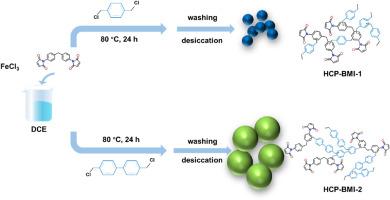富杂原子超交联聚合物对氯四环素的快速吸附
IF 4.7
3区 材料科学
Q1 CHEMISTRY, APPLIED
引用次数: 0
摘要
传统吸附剂对氯四环素(CTC)的吸附动力学和吸附能力有限。本文以双马来酰亚胺(含N/O官能团)为单体,以DCX(1,4-双(氯甲基)苯)或BCMBP(4,4 ' -双(氯甲基)-1,1 ' -联苯)为交联剂,经一步Friedel-Crafts烷基化反应合成了两种双马来酰亚胺基超交联聚合物HCP-BMI-1和HCP-BMI-2。交联剂的选择显著影响聚合物的性能,包括形态、化学成分和孔隙结构。值得注意的是,HCP-BMI-2表现出由纳米颗粒自发聚集形成的非均匀排列的分层结构。与HCP-BMI-1相比,HCP-BMI-2具有更高的BET表面积(938 m2/g),孔隙体积增大(0.758 cm3/g, 80%中孔/大孔),杂原子含量增加(N: 2.96%, O: 10.02%)。这些特性有助于提高其吸附CTC的性能。由于其优异的亲水性和富含杂原子的骨架,hcp - bi -2实现了快速吸附(30分钟内吸附495 mg/g),在动力学和最大容量方面都优于大多数报道的吸附剂。机理研究表明,CTC的吸收受氢键、静电相互作用和π-π堆积的控制。此外,HCP-BMI-2在10次再生循环后仍保持较高的吸附效率,具有较强的可重复使用性。这项工作为设计高效去除CTC的高性能吸附剂提供了一种策略方法。本文章由计算机程序翻译,如有差异,请以英文原文为准。

Heteroatoms-rich hyper-cross-linked polymers for rapid adsorption of chlortetracycline
Conventional adsorbents often suffer from limited adsorption kinetics and capacity for chlortetracycline (CTC). Here, two dual maleimide-based hyper-crosslinked polymers (HCP-BMI-1 and HCP-BMI-2) via one-step Friedel-Crafts alkylation were synthesized using bismaleimide (containing N/O functionalities) as the monomer and DCX (1,4-bis(chloromethyl)benzene) or BCMBP (4,4′-bis(chloromethyl)-1,1′-biphenyl) as cross-linkers. The choice of cross-linker significantly influenced polymer properties, including morphology, chemical composition, and pore structure. Notably, HCP-BMI-2 exhibited a hierarchical structure formed by the spontaneous aggregation of nanoparticles in non-uniform arrangements. Compared to HCP-BMI-1, HCP-BMI-2 displayed superior physicochemical properties: a higher BET surface area (938 m2/g), enhanced pore volume (0.758 cm3/g, 80 % meso/macropores), and increased heteroatom content (N: 2.96 %, O: 10.02 %). These characteristics contributed to its enhanced CTC adsorption performance. Owing to its excellent hydrophilicity and heteroatom-rich framework, HCP-BMI-2 achieved rapid adsorption (495 mg/g within 30 min), outperforming most reported adsorbents in both kinetics and maximum capacity. Mechanistic studies revealed that CTC uptake was governed by hydrogen bonding, electrostatic interactions, and π-π stacking. Moreover, HCP-BMI-2 retained high adsorption efficiency after 10 regeneration cycles, demonstrating robust reusability. This work provides a strategic approach to designing high-performance adsorbents for efficient CTC removal.
求助全文
通过发布文献求助,成功后即可免费获取论文全文。
去求助
来源期刊

Microporous and Mesoporous Materials
化学-材料科学:综合
CiteScore
10.70
自引率
5.80%
发文量
649
审稿时长
26 days
期刊介绍:
Microporous and Mesoporous Materials covers novel and significant aspects of porous solids classified as either microporous (pore size up to 2 nm) or mesoporous (pore size 2 to 50 nm). The porosity should have a specific impact on the material properties or application. Typical examples are zeolites and zeolite-like materials, pillared materials, clathrasils and clathrates, carbon molecular sieves, ordered mesoporous materials, organic/inorganic porous hybrid materials, or porous metal oxides. Both natural and synthetic porous materials are within the scope of the journal.
Topics which are particularly of interest include:
All aspects of natural microporous and mesoporous solids
The synthesis of crystalline or amorphous porous materials
The physico-chemical characterization of microporous and mesoporous solids, especially spectroscopic and microscopic
The modification of microporous and mesoporous solids, for example by ion exchange or solid-state reactions
All topics related to diffusion of mobile species in the pores of microporous and mesoporous materials
Adsorption (and other separation techniques) using microporous or mesoporous adsorbents
Catalysis by microporous and mesoporous materials
Host/guest interactions
Theoretical chemistry and modelling of host/guest interactions
All topics related to the application of microporous and mesoporous materials in industrial catalysis, separation technology, environmental protection, electrochemistry, membranes, sensors, optical devices, etc.
 求助内容:
求助内容: 应助结果提醒方式:
应助结果提醒方式:


